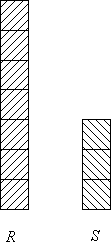Chirality: Optical purity vs ee
|
The specific rotation of the sample so obtained [
A pure enantiomer thus has 100% o.p., the racemate has 0% o.p.. Example: [R] : [S] = 70 : 30
The optical rotation of 30% S is compensated by 30% R. The measurement catches the optical rotation caused by the excess 40% R, thus o.p. = 40%. |




 ] is then compared to the specific rotation of a sample of a
pure enantiomer [
] is then compared to the specific rotation of a sample of a
pure enantiomer [